Middle East Investment Surge: Trends, Drivers, and Sector Insights
Updated On: November 13, 2025 by Aaron Connolly
Defining the Middle East Investment Surge
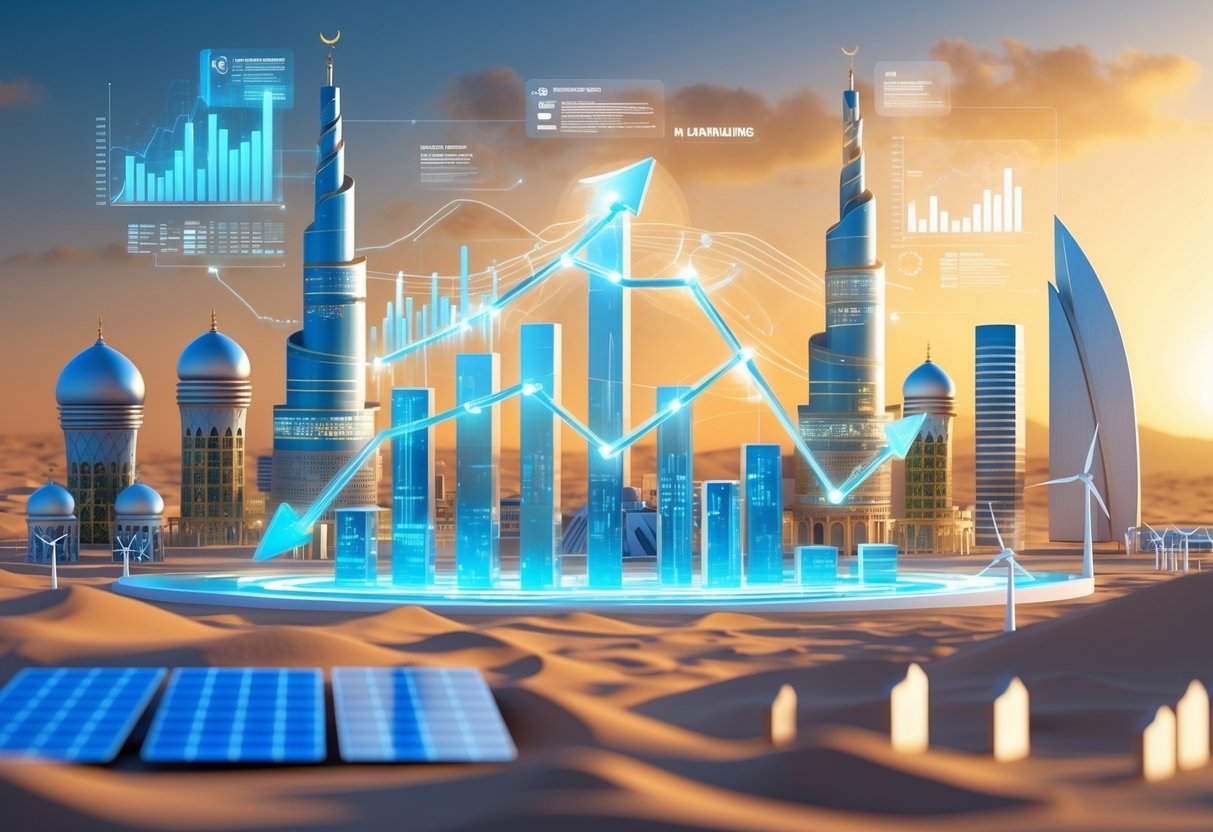
The Middle East investment surge signals a big change in where capital is flowing. In Saudi Arabia alone, foreign direct investment jumped 44% to $5.9 billion in just the first quarter of 2025.
This transformation cuts across technology, infrastructure, and new diversification plans in MENA countries. Sovereign wealth funds and government initiatives are really pushing this movement forward.
Key Characteristics of Recent Growth
Technology-Led Investment Focus
We’re seeing a huge push into artificial intelligence and digital infrastructure. Saudi Arabia rolled out a $15 billion AI investment at LEAP 2025, even teaming up with Google to build an AI hub in Dammam.
Abu Dhabi wants to go fully AI-powered by 2027, with $13 billion set aside for digital transformation. DataVolt also revealed a $5 billion sustainable AI data centre project in Oxagon, the floating city.
Sovereign Wealth Fund Activity
Middle Eastern sovereign wealth funds have flipped the script, investing more at home rather than just sending money abroad. Now, these funds are driving mergers and acquisitions, which climbed 19% in early 2025 to $58.7 billion across the region.
Cross-Border Investment Flows
International investors are catching on to Middle Eastern opportunities. The UAE has consistently pulled in over 40% of FDI projects in the region since 2003, peaking at 445 projects in 2019.
Scope and Geographic Focus
United Arab Emirates Leadership
The UAE stands out as the region’s financial hub, sitting right between Africa, Asia, and Europe. Dubai and Abu Dhabi keep attracting multinational companies looking for a base in the area.
Brexit and COVID-19 disruptions opened the door for MENA financial centres, especially those with friendly regulations and smoother visa processes.
Saudi Vision 2030 Impact
Saudi Arabia’s Vision 2030 plan is all about massive infrastructure spending, aiming to draw in 70 million international visitors by 2030. They only started offering non-religious tourist visas in 2019, which is pretty recent.
With plenty of energy resources, Saudi Arabia is in a strong spot for data centre development and semiconductor manufacturing.
Broader MENA Participation
Qatar pulled off a successful 2022 World Cup, showing the region can handle big projects. Other MENA countries are chasing economic diversification, moving away from just oil and gas.
Comparison to Past Investment Cycles
Historical Context Shift
Earlier, MENA investment cycles mainly followed the ups and downs of the energy sector. Now, investments target economic diversification, tech adoption, and tapping into a young population.
The region’s population—about 500 million—is expected to almost double by 2050. Right now, half of them are under 24.
Structural Differences
Unlike before, when commodity prices set the tone, today’s surge comes from government strategies and regulatory reforms. Private equity and venture capital are getting in on the action, beyond just the usual sectors.
Sustainability Focus
There’s a bigger emphasis now on renewable energy, sustainable infrastructure, and long-term planning. This is a clear break from the old short-term resource extraction approach.
It’s not just another cycle—it really feels like the region is transforming its economy, not just riding another commodity wave.
MENA’s Record-Breaking Deal Activity
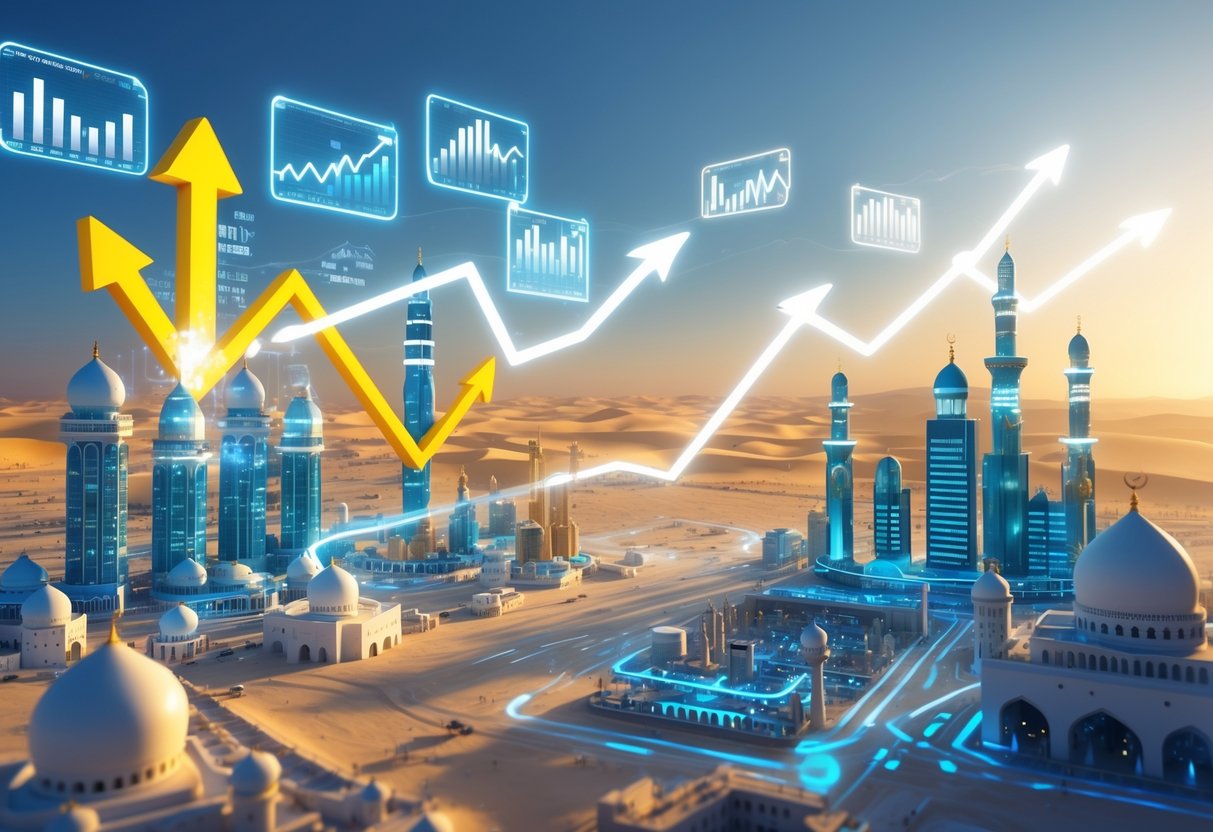
MENA just had its best deal performance in five years during the first half of 2025. There were 425 transactions worth $58.7 billion, with cross-border deals leading the way and domestic deals almost doubling in value.
Latest Deal Volume and Value
In the first half of 2025, MENA logged 425 mergers and acquisitions. That’s a 31% jump in deal volume compared to the same time last year.
Total deal value hit $58.7 billion, up 19% year-on-year. This momentum follows 2024’s regulatory reforms and better economic policies.
Deal activity stayed strong, even though Q2 saw a bit of a slowdown. Global trade tensions and geopolitics did throw in some challenges.
The most active sectors were:
- Chemicals and petrochemicals
- Technology
- Industrial products
- Real estate
Cross-Border and Domestic Transactions
Cross-border deals really set the pace in early 2025, making up 55% of deal volume and 78% of total value.
There were 233 cross-border deals adding up to $45.9 billion. That’s the highest cross-border activity in five years and a 40% increase in deal volume.
| Transaction Type | Deals | Value (USD) | % of Total Value |
|---|---|---|---|
| Cross-border | 233 | $45.9bn | 78% |
| Domestic | 192 | $12.8bn | 22% |
Domestic M&A activity stayed solid, with 192 deals worth $12.8 billion. That’s a 22% rise in volume and a 94% leap in value from last year.
The UAE pulled in half of all inbound deal volume. Austria surprisingly led inbound investment, pouring in 77% of the total value.
Notable Mega-Deals
Borealis AG and OMV AG’s $16.5 billion acquisition of a 64% stake in Borouge plc was the biggest deal. It shows there’s still a strong appetite for large, strategic investments in chemicals.
Group 42’s $2.2 billion purchase of a 40% stake in Khazna Data Centre topped domestic deals, highlighting the growing interest in data infrastructure.
Some key outbound deals:
- ADNOC and OMV AG’s acquisition of Canada’s Nova Chemicals
- Saudi Aramco’s $3.5 billion buyout of Primax in South America
Sovereign wealth funds made a huge impact, with ADIA, PIF, and Mubadala involved in 54 transactions worth $21 billion together.
The UAE and Saudi Arabia together made up 87% of outbound deal value. These two markets brought in a combined $27.9 billion in investments in the first half of 2025.
UAE’s Role as an Investment Powerhouse
The UAE pulled in AED 112.6 billion in foreign direct investment during 2023—a 35% surge. This growth really cements its spot as the Middle East’s top investment destination.
Strategic sector diversification and regulatory reforms have made the UAE a magnet for global capital.
Top Destination for Foreign Capital
The UAE locked in the top spot for FDI in West Asia and the MENA region. In 2023 alone, foreign investment inflows hit $16 billion in foundational investments.
This uptick had a real impact—job creation climbed 7.5%, and foundational FDI inflows rose by 37%. International investors clearly see the UAE as a safe bet for steady returns.
Over 1.1 million companies now call the UAE home. In 2024, authorities handed out 200,000 new economic licences, showing the business scene keeps expanding.
The UAE’s location—right where Europe, Asia, and Africa meet—gives it unmatched market access. Political stability and top-notch infrastructure make it a natural hub for businesses eyeing the Middle East and North Africa.
Key Sectors Attracting Investment
Business services and software are leading the investment rush. IT and financial services are right behind, with industrial equipment also drawing interest.
Emerging industries are catching on fast:
- Renewable energy projects
- Electric vehicle manufacturing
- Cloud computing infrastructure
These sectors are opening up fresh opportunities in the UAE’s fast-changing economy. By moving away from oil, the country is attracting global capital looking for new growth.
Financial services get a big boost from the UAE’s tax-friendly environment. Abu Dhabi and Dubai have become go-to spots for international banking, fintech, and asset management.
Family offices are flocking to the UAE too. The regulatory setup supports wealth management and connects them to global markets.
Strategic National Initiatives
Over the last four years, the UAE rolled out more than 30 new laws and policies. These changes have made sectors like e-commerce, family businesses, trademarks, and consumer protection stronger.
Abdullah bin Touq Al Marri, Minister of Economy, credits this competitive legal environment for driving growth. The regulatory system keeps evolving to suit investors’ needs.
By the end of 2024, the UAE’s capital markets hit a $1 trillion milestone in market cap. That’s drawing in international institutional investors and setting up a strong pipeline of future deals.
Economic diversification is at the heart of the government’s plan. They’re actively promoting non-oil sectors, building a more resilient economy that appeals to long-term investors.
Saudi Arabia’s Transformation and Attractiveness
Saudi Arabia is quickly becoming a major investment destination, thanks to bold economic reforms and huge infrastructure projects. In Q1 2025, foreign direct investment soared 44% to $5.9 billion, with the country’s sovereign wealth fund pushing innovation across several sectors.
Vision 2030 and Economic Reform
Vision 2030 is Saudi Arabia’s roadmap for diversifying the economy beyond oil. The plan aims for $100 billion in foreign direct investment by 2030, creating jobs in tourism, sports, and entertainment.
Recent regulatory changes have reshaped the Kingdom’s business landscape. Since 2021, international companies wanting government contracts must set up regional headquarters in Saudi Arabia. This rule is speeding up company relocations and boosting local jobs.
Visa liberalisation has made it much easier to do business. More multinational corporations are using Saudi Arabia as their entry point to the wider Middle East and North Africa.
The numbers tell the story. FDI as a share of GDP hit its 2023 target, with total inflows reaching SAR 96 billion ($25.6 billion)—a 50% jump from 2022, not counting one-off deals.
Investment is spreading across more industries and regions now, not just oil or the eastern provinces.
Sovereign Deals and Innovation
The Public Investment Fund (PIF) is one of the world’s biggest sovereign wealth funds, with nearly $1 trillion in assets. PIF backs national champions and builds technical expertise across its investment portfolio.
But, not everything goes perfectly. The fund recently wrote down $8 billion on some high-profile gigaprojects, showing that delivering massive infrastructure isn’t always smooth sailing.
PIF keeps focusing on localising industries and driving innovation in key sectors. They seem more interested in building long-term capabilities than chasing quick wins.
At the Future Investment Initiative Summit in Miami (February 2025), PIF unveiled plans for international expansion. The “Invest with Purpose” theme put the spotlight on sustainable and strategic investments.
Growth in Technology and Industry
Saudi Arabia’s capital markets are changing fast, helping the Gulf Cooperation Council become a new financial hub. Local market growth is drawing in international investment firms.
Tech investments are picking up speed. The Kingdom gives incentives and easier regulations to lure tech companies and startups.
Manufacturing and industrial growth get strong government support. New industrial cities and special economic zones offer space and infrastructure for global manufacturers.
Green energy is a big focus. Solar and wind projects fit both Vision 2030 and worldwide sustainability trends.
Entertainment and tourism are booming too. New destinations, major events, and cultural projects are creating revenue streams beyond oil.
The Expanding Influence of Sovereign Wealth Funds
Middle Eastern sovereign wealth funds now hold about 40% of all global SWF assets. In 2023, Gulf funds alone deployed £82 billion, with another £55 billion going out in just the first nine months of 2024.
These investment giants are changing the flow of money worldwide. They’re moving beyond Western markets and putting big bets on Asia, Africa, and emerging tech.
Regional and Global Investment Strategies
Gulf sovereign wealth funds are shifting their focus toward Asia-Pacific markets in a big way. We’re watching these funds open new offices throughout the region and pour larger allocations into high-growth economies.
China, in particular, is drawing a lot of attention. Middle Eastern funds put about £9.5 billion into China during the year ending September 2024. ADIA and Kuwait Investment Authority both landed in the top 10 shareholders of Chinese A-Share listed firms.
Western investors are pulling back from China, and Gulf funds are stepping in. They’re taking advantage of strong political and trade ties with Beijing to fill that gap.
Africa’s also on their radar. The UAE and Saudi Arabia are jumping into high-risk mining ventures across Africa. They’re channeling investments both directly and through stakes in global mining companies.
These funds have rolled out new investment vehicles called “Royal Private Offices.” Now, these entities manage an estimated £500 billion in assets, giving them more freedom to try different investment strategies.
Leading Funds’ Recent Moves
Five big players are steering most of the action:
- Abu Dhabi Investment Authority (ADIA)
- Mubadala (Abu Dhabi)
- Abu Dhabi Developmental Holding Company
- Public Investment Fund (PIF) – Saudi Arabia
- Qatar Investment Authority (QIA)
Saudi Arabia’s PIF hit the £1 trillion asset mark in 2024. Still, the fund saw net profit drop 60% to £25.8 billion, which just shows how even the giants feel the pinch when markets shift.
These funds are getting more assertive with their portfolios. They’re quicker to sell off underperforming assets and they push for better reporting from their portfolio companies. Boardroom influence? That’s on the rise too.
Human capital is now intensely contested. Gulf SWFs employ around 9,000 professionals these days. They’re offering eye-catching packages to lure senior talent, especially those with backgrounds at Singapore’s Temasek or Canada’s Maple Eight.
This battle for talent shows how these funds have moved from being passive investors to demanding, sophisticated global operators. They’re chasing stronger returns and better governance.
Economic Diversification and Policy Reforms
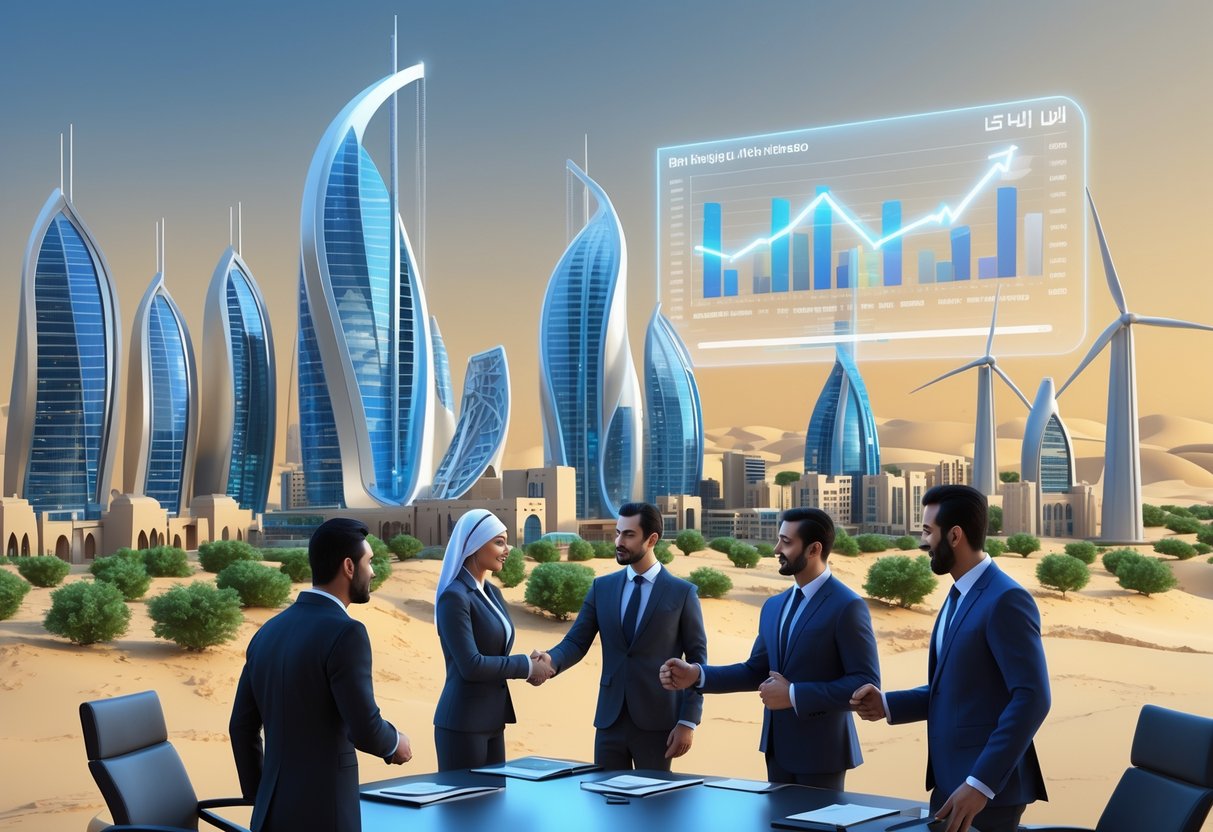
Middle Eastern countries are racing to overhaul their economies and reduce oil dependence. They’re rolling out business-friendly laws and inviting private companies to take the lead on growth.
Shifting Beyond Oil and Gas
Gulf states have made big strides in moving away from oil. Abu Dhabi’s non-oil trade jumped 34.7% in the first half of 2025 compared to the same time last year.
Saudi Arabia’s Vision 2030 aims to ramp up renewable energy, with huge solar farms and green hydrogen plants popping up in the NEOM megacity.
The UAE’s Energy Strategy 2050 zeroes in on clean energy. Dubai’s Mohammed bin Rashid Al Maktoum Solar Park keeps drawing in billions from global investors.
These countries are using their vast deserts for solar projects. All that sunshine? It’s perfect for renewable power.
Economic diversification now means three things:
- Output diversification – building new industries
- Trade diversification – finding fresh export markets
- Revenue diversification – lowering government reliance on oil
Investor-Friendly Regulatory Changes
Governments in the Middle East have revamped their rules to attract foreign capital. The UAE, Saudi Arabia, and Qatar now let foreigners own 100% of companies in many sectors.
Regulatory sandboxes have popped up for fintechs to test new products. These frameworks let businesses try out ideas without jumping through every regulatory hoop right away.
Digital banking reforms are shaking up financial services. Countries are loosening rules on cryptocurrency and blockchain.
Private equity firms now benefit from simpler deal structures. New laws protect investor rights and cut red tape.
Free zones sweeten the deal with perks like:
- Zero corporate taxes for a set time
- Full profit repatriation
- Quick business setup
- Access to skilled international workers
Empowering Private Sector Growth
Governments are moving away from running everything themselves. Now, they’re handing more of the reins to private businesses, which means more chances for local and global players.
Public-private partnerships are funding major infrastructure—think airports, ports, and smart cities.
Funding for economic diversification used to come from oil. These days, private equity investment is taking on a bigger role as oil prices swing.
There’s a clear push for private sector growth, especially for small businesses and startups. Governments are backing venture capital funds to invest in tech firms.
Hot private sector areas include:
- Technology and artificial intelligence
- Healthcare and life sciences
- Tourism and hospitality
- Logistics and e-commerce
A lot of countries now offer entrepreneur visas and startup incubators. These programs help international firms set up regional HQs in Dubai, Riyadh, and Doha.
Private Equity and Venture Capital Trends
Private equity deals in the Middle East hit $27.6 billion over five years. Meanwhile, venture capital funding soared to $678 million just in Q1 2025. Investors are shifting focus to technology, healthcare, and renewables as they look beyond oil.
Rising Deal Flow in Non-Oil Sectors
Middle Eastern private equity and venture capital have changed a lot lately. The region saw $2.28 billion in private equity deals by September 2024—almost double the $1.19 billion from Q1.
Tech and artificial intelligence are leading this charge. Qatar’s Ooredoo raised $550 million for AI and data centers. Saudi Arabia kicked off ‘Project Transcendence’, a $100 billion AI investment.
Healthcare is another major area. In Saudi Arabia, 53% of healthcare investments now come from private sources. It’s a big sign of the country’s move away from oil.
Private equity deal volumes ticked up, helped by more international deals. The region logged 108 private equity transactions, showing that foreign investors are gaining confidence.
Renewables are drawing in fresh investment too. Both sovereign wealth funds and global private equity firms are chasing growth in these sectors.
Market-Leading Countries and Sectors
Saudi Arabia grabbed the lead in 2023, with 41% of all private equity deals. That’s a big shift from the UAE’s earlier dominance.
The UAE, Saudi Arabia, and Egypt make up the top three markets for private equity deals from 2020 to 2024. They’ve built strong regulatory systems and offer plenty of support for private investors.
The main sectors pulling in money:
- Artificial Intelligence and Technology
- Renewable Energy and Infrastructure
- Healthcare and Life Sciences
- Financial Services and Fintech
Right now, 65% of regional investors are keeping or increasing their private equity stakes. At the same time, 56% plan to boost venture capital exposure, which shows there’s still a strong appetite for alternative assets.
Egypt’s $35 billion ADQ-led deal stands as the region’s biggest privatization. It’s pulling in foreign capital and fueling private sector growth in several industries.
Major Recent Transactions
Billion-dollar deals jumped from just one in 2023 to five in 2024. The largest deal hit $3.6 billion, which says a lot about investor confidence.
Bayanat AI’s $1.5 billion buyout of Al Yah Satellite Communication put the spotlight on the region’s tech ambitions. That’s a big move for AI investment.
Masdar’s $2.7 billion purchase of Greece’s Terna Energy shows Middle Eastern firms aren’t just looking inward—they’re expanding globally, especially in renewables.
Worldwide, private equity deals over $1 billion climbed from 430 in 2023 to more than 500 in 2024. That’s an 11% jump in average deal size, driven by more assets coming to market.
We’re expecting more than half of regional CEOs to plan acquisitions in the next three years. Cross-border M&A is still changing the Middle East’s investment landscape.
Sector Spotlights: Technology, Real Estate, and Industrial Growth

Three sectors are really fueling the Middle East’s investment surge. Tech and AI hit new highs in 2024, and real estate is still growing strong in major cities.
Technology and Artificial Intelligence
The region’s tech sector exploded in 2024, with several billion-dollar deals making waves. Bayanat AI’s £1.2 billion buyout of Al Yah Satellite Communication was a huge step for tech consolidation.
Some standout tech deals:
- Qatar’s Ooredoo raised £440 million for AI and data centers
- Saudi Arabia rolled out ‘Project Transcendence’ with £80 billion for AI
- Private equity tech deals reached 108 transactions
Governments are all-in on digital transformation now. The UAE and Saudi Arabia lead in AI, especially in smart cities and autonomous tech.
Tech startups are getting more support from sovereign wealth funds. Regional venture capital activity climbed 15% year-over-year, with fintech and healthtech drawing the most interest.
Cross-border tech deals are picking up. Middle Eastern firms are going global, and international companies are setting up shop in Dubai and Riyadh.
Real Estate and Infrastructure
Real estate markets in the Middle East held up well, even with global challenges. Saudi Arabia and the UAE keep pulling in international investment, and Egypt’s market is bouncing back.
Real estate highlights:
- Dubai home prices jumped 12% in 2024
- Saudi Arabia’s NEOM project secured another £25 billion
- Egypt’s New Administrative Capital drew £8 billion in private investment
PropTech is gaining real traction. Digital platforms now handle 40% of property deals in big cities, making things easier for investors and residents.
Spending on infrastructure stays high, especially in transport and utilities. Airports, ports, and railways are expanding to keep up with trade and tourism.
Foreign investors are snapping up real estate. International buyers made up 35% of luxury sales in Dubai, and Riyadh is seeing more commercial property investment.
Industrial and Chemicals Expansion
Industrial growth is picking up speed across MENA, pushed by diversification and the switch to sustainable energy. Masdar’s £2.2 billion deal for Greece’s Terna Energy underlines the region’s renewable energy ambitions.
Industrial sector updates:
- Green hydrogen projects worth £15 billion are underway in Saudi Arabia and the UAE
- Regional chemical manufacturing capacity rose 8%
- Logistics infrastructure is growing to support more trade
Private companies are getting more involved in industries once dominated by governments. In Saudi Arabia, private firms now provide 53% of healthcare investments—a sign that diversification is working.
Manufacturing is moving up the value chain. The region is focusing on advanced materials, pharmaceuticals, and clean energy tech, which is attracting global manufacturers.
Strategic industrial hubs are springing up. Free zones in Dubai, Abu Dhabi, and Riyadh offer real advantages for international firms setting up in the Middle East.
Artificial Intelligence’s Emergent Role in Investment

Artificial intelligence is shaking up investment decisions and deal-making all over the Middle East. The UAE and Saudi Arabia are leading the way with huge AI projects, backed by government support and billions in funding.
Enhancing Dealmaking Efficiency
AI is shaking up how investment firms look at opportunities and manage their portfolios. Investors now process huge amounts of data in no time, spot market trends, and make sharper decisions.
Key efficiency improvements include:
- Automated due diligence processes
- Risk assessment algorithms
- Real-time market analysis
- Predictive investment modelling
Investment firms in the Gulf Cooperation Council region say AI brings in £9.90 of economic growth for every £1 invested. That kind of return explains why so many Middle Eastern organisations are in a rush to bring in these technologies.
AI speeds up deal completion times too. What used to take weeks now wraps up in days, giving Middle Eastern firms a real edge in fast-moving markets.
Many investment professionals say AI is especially useful for climate-tech investments. AI-related climate companies in the region pulled in $47.3 million in 2024, jumping up from just $5.4 million in 2023.
AI Initiatives in the UAE and Saudi Arabia
The UAE rolled out its Artificial Intelligence Strategy 2031, aiming to cut government costs by half using AI. Abu Dhabi set up the Artificial Intelligence and Advanced Technology Council to guide policies and invest in infrastructure.
Dubai appointed 22 chief AI officers in June 2024. They placed them in key departments like Dubai Police, Dubai RTA, and the Department of Tourism and Economy.
Saudi Arabia’s major AI investments:
- $40 billion AI investment fund led by the Public Investment Fund
- Partnership with US firm Andreessen Horowitz
- Saudi Data and Artificial Intelligence Authority (SDAIA)
- National Strategy for Data and AI (NSDAI)
Both countries are building AI capabilities as part of their plans to move beyond oil. Saudi Arabia’s Vision 2030 puts AI and digital transformation right at the centre of its economic overhaul.
The region wants to capture 2% of global AI benefits by 2030. That’s about $320 billion in economic impact across Middle Eastern markets.
Global Capital Flows and Strategic Partnerships

The Middle East has turned into a major crossroads for global capital. Regional sovereign wealth funds pour billions into international markets, and foreign investors are eyeing Middle Eastern opportunities more than ever.
Inbound Investments and Top Sources
Asia leads the charge in Middle Eastern deal volume. Chinese and Japanese firms are behind much of the mergers and acquisitions action, especially in energy transition and digital infrastructure.
The numbers are hard to ignore. Total deal value from Asian investors into the Middle East jumped 15% in 2024, hitting new highs.
Key inbound investment sources include:
- Chinese sovereign funds targeting renewable energy
- Japanese trading houses in infrastructure deals
- South Korean tech giants building AI research centres
- Indian conglomerates forming manufacturing partnerships
European capital stays steady but pretty selective. German and French investors focus on industrial projects that fit the region’s push to diversify.
US investment faces some headwinds from changing trade policies and geopolitics. Still, private equity firms keep chasing high-value deals in tech and healthcare.
Outbound Expansion and Regional Impact
Gulf sovereign wealth funds are changing global capital markets with bold outbound moves. We’re seeing regional capital flow into US and European markets at levels nobody expected a few years ago.
Mergers and acquisitions from Middle Eastern buyers reached $4.4 billion globally in 2024. UAE and Saudi players led the way, picking up strategic assets in developed markets.
The outbound flow creates three major impacts:
| Impact Area | Regional Effect | Global Influence |
|---|---|---|
| Technology | Local AI ecosystems | Silicon Valley partnerships |
| Energy | Hydrogen production | European grid investments |
| Infrastructure | Smart city projects | Global logistics networks |
Qatar and UAE funds are especially active in cross-border private equity. They often skip traditional fund structures, choosing direct co-investments instead, which cuts fees and gives them more control.
Bringing international expertise home has real benefits for the region. Local companies pick up new technologies and management practices through these partnerships.
Deal volume keeps climbing as Middle Eastern investors look to diversify beyond oil.
Geopolitical and Market Forces Shaping the Surge
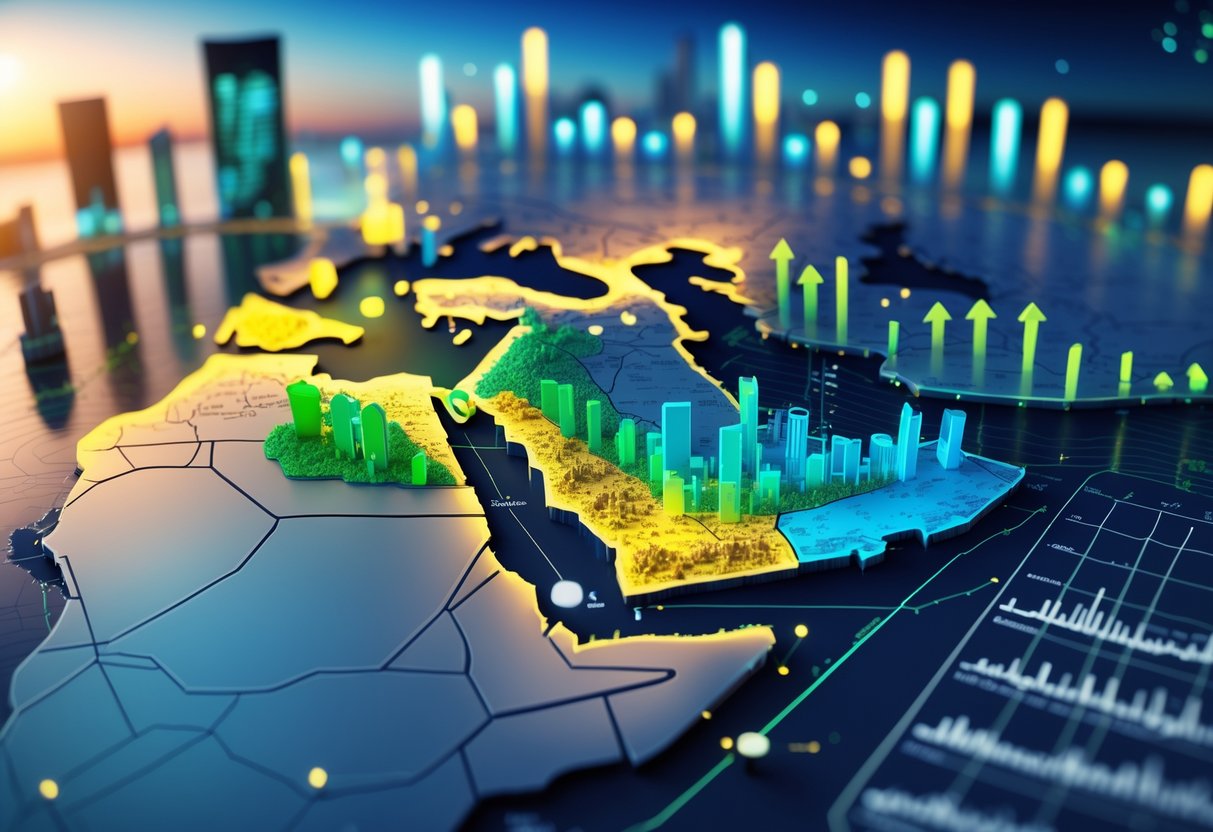
Three big forces are behind the flood of investments into the Middle East: a shift away from oil, and complicated geopolitical changes that open doors but also bring new risks for investors.
Macroeconomic Drivers
The region’s economy is changing fast. Oil prices have shot up to $70 per barrel, giving governments huge revenue streams.
But the real story is about diversification. Saudi Arabia’s $250 billion clean energy partnership with Siemens Energy is a good example. The UAE’s $500 billion NEOM megacity project shows how petrodollars are moving into future-focused infrastructure.
Interest rate cuts in major economies are sending more global capital toward higher-yield regions. The Middle East stands out, especially while central banks keep policies loose.
Currency stability in the region is another draw. The UAE dirham and Jordanian dinar have stayed steady even as other currencies swing.
Energy transition investments now offer the biggest potential. Australia, for instance, has shifted $5 billion from coal exports into renewable energy deals with Gulf states. That’s opening new trade routes and investment streams.
Governments across MENA are making it easier for investors. They’re offering tax breaks and faster approvals for ESG-friendly projects.
Geopolitical Opportunities and Risks
Geopolitical recognition of Palestine by over 145 countries has made the investment landscape more complicated. This diplomatic shift has raised tensions but also opened new markets.
Infrastructure risks have jumped by 40%, says the World Bank. Project delays happen more often, and shipping insurance through the Strait of Hormuz has gone up a lot.
Still, savvy investors see opportunities in the chaos. Jordan and Egypt are emerging as strong alternatives to the Gulf. Their locations and stable policies attract infrastructure projects.
The recognition trend has put more focus on ESG investing. Companies with solid environmental and governance records get better market access. Those who don’t face extra scrutiny.
Geographic diversification is now a must. Saudi Arabia and the UAE are still key, but investors spread their bets across more MENA countries to cut risk.
Regulations vary a lot in the region. Countries that align with global diplomatic trends generally offer better protection and clearer legal rules for investors.
Future Outlook for Investment in the Middle East
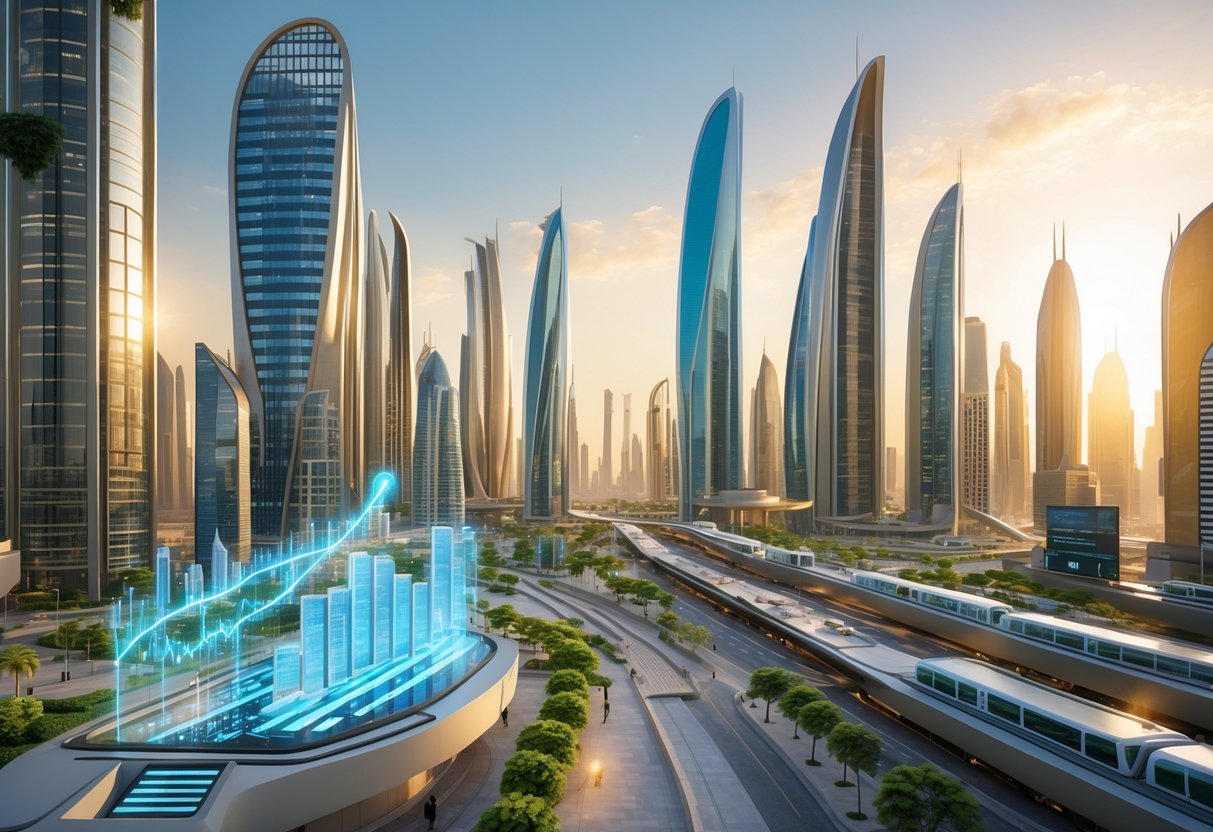
The Middle East’s investment scene is a mix of big opportunities and stubborn challenges. Young populations and rapid urban growth are creating fresh markets, but geopolitical tensions and tricky regulations keep investors on their toes.
Challenges and Opportunities Ahead
Investment activity in the Middle East will run into some hurdles in the coming years. Political instability worries plenty of international investors, especially with shifting regulations and cross-border friction.
Currency swings tied to oil prices still affect returns. Water scarcity and climate change add long-term infrastructure headaches that need a lot of capital.
But here’s the upside: the region’s projected $4.1 trillion GDP means huge market access. Governments are rolling out incentives like:
- 100% foreign ownership in key sectors
- Tax holidays up to 10 years
- Sovereign wealth fund partnerships worth billions
The move away from oil is picking up speed. Saudi Arabia’s Vision 2030 alone represents $1.3 trillion in active projects. The UAE’s fintech sector now has over 800 companies, and Egypt’s Suez Canal Economic Zone offers zero customs duties.
Green energy looks especially promising. Qatar’s $45 billion LNG expansion and Egypt’s $40 billion green hydrogen deals with the EU show just how big the opportunities can get.
Impact of Demographic and Social Shifts
The Middle East’s young population is changing investment priorities across sectors. Over 60% of people here are under 30, driving demand for digital services, education, and consumer goods.
Urbanisation is moving at breakneck speed. Saudi Arabia’s NEOM and Qatar’s Lusail City are new urban models that need massive infrastructure. These smart cities want everything from modern transport to digital healthcare.
Rising female workforce participation is opening up new market segments. The UAE leads with women making up 66% of government employees. In Saudi Arabia, female labour participation has climbed from 20% to 35% since 2017.
Digital adoption rates are among the world’s highest. That’s a big opening for fintech, e-commerce, and digital healthcare. Israel’s AI sector alone boasts over 1,600 startups, and the UAE processes millions of digital transactions daily.
Consumer spending is shifting toward services and experiences. Tourism is booming, with Dubai expecting 28 million visitors in 2025 and Saudi Arabia aiming for 100 million by 2030.
Frequently Asked Questions
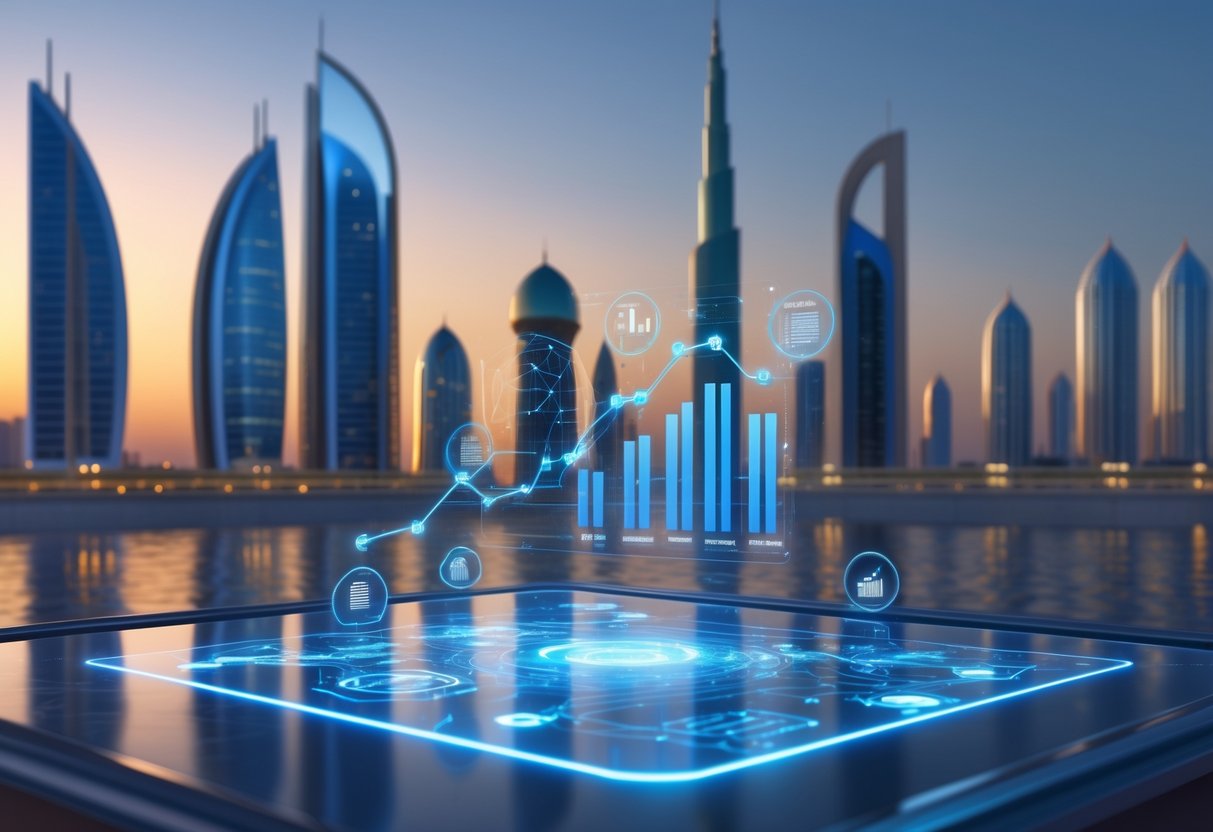
Investors looking at the Middle East usually want to know about emerging sectors, geopolitical risks, and how local regulations work. There’s a lot of potential here, but you really need to understand the local scene and government policies.
What are the emerging sectors attracting foreign investment in the Middle East?
Technology and artificial intelligence are leading the investment wave. The UAE has over 800 fintech companies in its free zones. Saudi Arabia kicked off a $380 million AI strategy focused on quantum computing and autonomous systems.
Renewable energy projects are taking centre stage. Saudi Arabia plans 58.7 GW of renewable capacity by 2030. Qatar is pouring $45 billion into green energy alongside its LNG push.
Healthcare technology and digital services are also growing fast. Israel has more than 1,600 AI startups, many working on medical diagnostics and precision medicine. The sector benefits from high R&D spending—about 4.9% of GDP.
Mining and metals are opening up too. Saudi Arabia is unlocking $1.3 trillion in untapped mineral resources. The country now lets foreign investors fully own mining licences for rare earths and traditional minerals.
How are geopolitical dynamics influencing investment trends in the region?
US trade policy changes are making things a bit uncertain for some investors in 2025. Lower oil prices can slow government spending on mega-projects. Still, most Gulf states have strong sovereign wealth funds, so infrastructure investment continues.
The Abraham Accords opened new business channels between Israel and Arab nations. Israeli cybersecurity and water tech firms now work with UAE, Bahrain, and Saudi partners on big projects.
Regional stability isn’t the same everywhere and affects risk premiums. Egypt gets European support through EBRD and AfDB funding, which helps lower political risk. The Suez Canal’s strategic role keeps international backers interested in Egyptian projects.
China’s Belt and Road Initiative keeps moving despite global tensions. Over $10 billion in Chinese investment flows through Egypt’s Suez Canal Economic Zone. UAE and Saudi Arabia are balancing relationships with both US and Chinese investors.
Can you highlight the top countries in the Middle East for business expansion?
The UAE still leads for foreign investment. Dubai and Abu Dhabi offer 100% foreign ownership, zero corporate tax for qualifying businesses, and advanced infrastructure. The country expects 28 million visitors in 2025.
Saudi Arabia brings the region’s biggest market with over $1.3 trillion in active projects. Vision 2030 opens doors in NEOM, Qiddiya, and Red Sea developments. The Public Investment Fund teams up with international investors on mega-projects.
Israel has one of the world’s most mature innovation ecosystems. Tel Aviv ranks among top startup hubs for AI, cybersecurity, and biotech. The country keeps up strong trade ties even with regional tensions.
Qatar is focused on LNG expansion and smart city projects. The North Field project will boost LNG output to 126 million tonnes yearly by 2027. Lusail City and Msheireb Downtown show off urban technology in action.
Egypt gives access to 110 million consumers and African markets. The New Administrative Capital and Suez Canal Economic Zone offer industrial opportunities. High-speed rail will soon connect Mediterranean and Red Sea ports by 2027.
What measures are Middle Eastern governments taking to encourage international investments?
Free zones and special economic areas play a big role here. The UAE lets foreign investors own 100% of their businesses and gives tax holidays in specific zones.
Egypt’s Suez Canal Economic Zone cuts out customs duties and makes port access much easier.
Sovereign wealth funds help lower risks for investors. Saudi Arabia’s Public Investment Fund jumps in to co-invest in global projects.
Qatar Science & Technology Park hands out grants and runs startup accelerator programs.
Regulatory sandboxes give fintech and tech companies a chance to experiment. Dubai International Financial Centre and Abu Dhabi Global Market let firms test new ideas with looser rules.
Bahrain stands out in the region for leading open banking regulations.
Long-term residency programs try to pull in entrepreneurs and skilled professionals. The UAE hands out golden visas to investors and experts.
Saudi Arabia rolled out premium residency for business owners and talented workers.
Governments have started to streamline business setup. Now, most countries offer online company registration.
They also fast-track licenses for key sectors like renewable energy and tech.
How does the regulatory landscape affect new investments in the Middle East?
Banking and financial service rules now match up with international standards. Both the UAE and Bahrain stick to Basel III requirements.
Qatar FinTech Hub sets out straightforward licensing for payment and lending companies.
Foreign ownership rules really depend on the country and sector. The UAE lets you own 100% of your business in most areas.
Saudi Arabia still keeps some restrictions in sensitive industries, but has opened up mining and renewable energy.
Tax systems often work in favor of international investors. The UAE doesn’t charge corporate tax for most businesses.
Saudi Arabia gives tax holidays for manufacturing and tech investments. Egypt offers 10-year tax exemptions in industrial zones.
Intellectual property protection keeps getting stronger across the region. Israel has top-notch IP enforcement.
The UAE and Saudi Arabia have sped up patent processing and improved trademark protection to attract tech companies.
Labour law reforms make things easier for foreign workers and managers. Saudi Arabia relaxed sponsorship rules for skilled workers.
The UAE extended work visa validity and made it simpler to transfer residency between employers.
What are the major risks to consider when investing in Middle Eastern markets?
Some markets feel currency volatility more than others. The Egyptian pound, for example, swings in value and makes long-term planning tricky.
Gulf currencies, on the other hand, tend to stay steady. Oil reserves and sovereign wealth funds give them a solid financial cushion.
Regulatory changes can shake up business operations overnight. Saudi Arabia keeps investors guessing with its rapid economic shifts.
If you want to navigate these changes, you’ll need local partners who actually get the ever-changing compliance rules.
Geopolitical tensions often spill over into trade and investment. Iran sanctions, for instance, shut down certain business routes.
Most Gulf states, though, hold onto stable ties with their main trading partners.
A lot of markets lean heavily on government-led projects. That means you often have to get the green light from sovereign wealth funds or government bodies.
Private sector growth? It really depends on where you look—some countries push it more than others.
Culture and business practices can trip up outsiders. Contract enforcement, dispute resolution, and relationship management just don’t follow Western blueprints.
If you want to succeed, you’ll need to invest time in understanding local customs and building real trust with regional partners.

